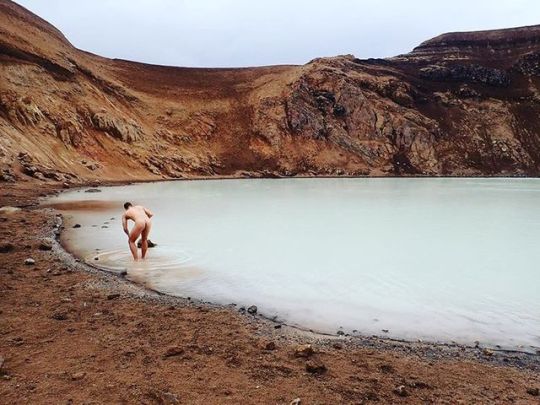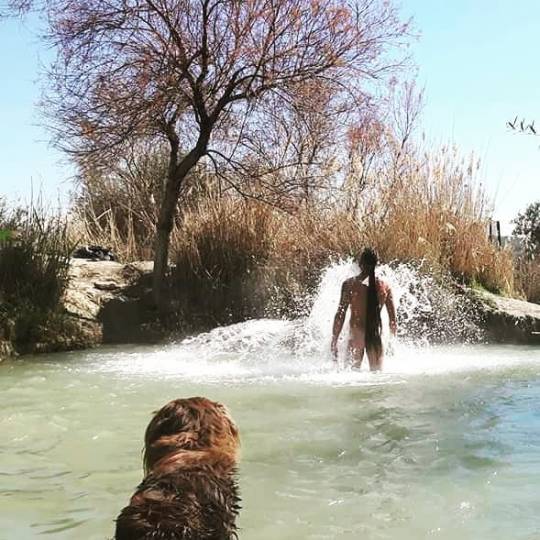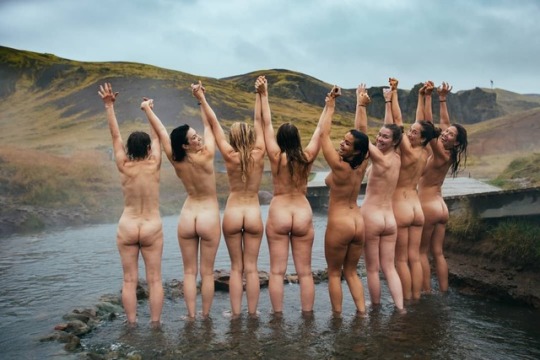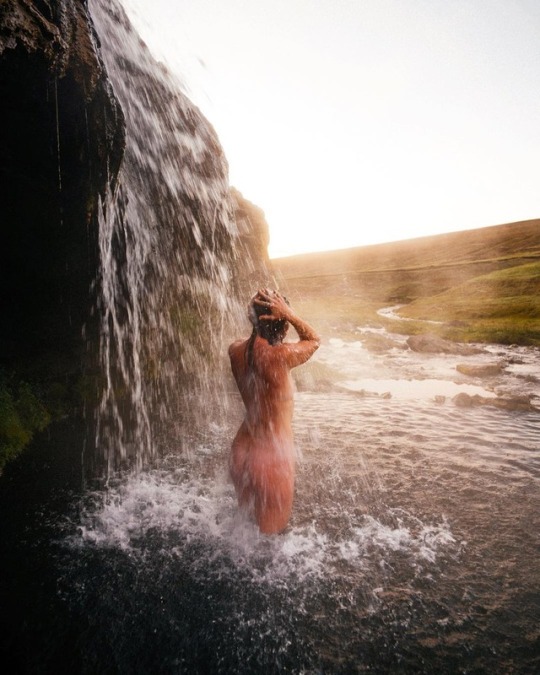4 days until Iceland. Naked in Nature. ・・・Tag for repost. ・・・#hotsprings #nature #iceland #craterlake#travel #traveling#socialenvy#PleaseForgiveMe #vacation #visiting#instatravel #instago#instagood #trip#photooftheday #fun #traveling#instapassport#instatraveling#mytravelgram #travelgram #travelingram#igtravel
Another more or less in-depth look at a specific Icelandic hot pot.
Referred to as either Askja or Viti, this is actually a crater lake: remote, not so accessible and creamy coloured. And naturally heated.
What's more to add?
You can find more info over on Wikipedia, though the official tourist site northiceland.is has better info and I think this intro gives a good starter:
You can find more info over on Wikipedia, though the official tourist site northiceland.is has better info and I think this intro gives a good starter:
'Askja is a 50 km2 caldera in the Dyngjufjoll mountains. The mountains emerged in eruptions under an Ice Age glacier cap. Askja itself was formed, for the most part, at the end of the Ice Age in a major ash eruption which caused the roof of the magma chamber at the heart of the central volcano to subside.
Askja is a part of Vatnajökull National Park.
The caldera contains several volcanoes, including Víti (explosive volcanic crater). Water has accumulated in the crater, its temperature is variable - it is around 30°C on average. Víti is a popular bathing site, but if you intend taking a dip, please be aware that the sloping path is very slippery in wet weather.
...
On this road there are fords on the rivers Grafarlandsá and Lindá that need to be crossed. The fords can be difficult or even impassable for small jeeps'.
lina_tsupikova sharing a photographic overview of Viti lake (in foreground) and Öskjavatn in the background:
А вы когда- нибудь купались в действующем вулкане)? Идешь себе по снежным горам, кутаясь в зимнюю одежду, и тут раз - посреди гор горячее озеро непередаваемого белого цвета прямо в кратере вулкана! Вот такой он вулкан Аскья! #trip #travel #icelandtrip #iceland #askja#nature #aroundtheworld #mountains#volcano #crater#swimminginvolcanoes #vitilake#vatnajökull
'The Askja caldera includes a few volcanoes and craters including one of Iceland’s most famous one Víti, meaning Hell. Víti is an explosive volcanic crater but water has accumulated in the crater and the temperature of the water is around 30°C or 86ºF. This makes the volcanic crater a popular bathing site but we only recommend it for those who have done their research on the water temperature and the location’s conditions before. Also the path down is often very slippery, especially in wet weather'.
Stripped
The complete surroundings are very photogenic area and most probably after the lengthy drive-in, tourists are encouraged to stretch their legs and attempt to seek the shores of Viti and gather some courage to take a soak.
aubreelaura shares:
It takes about 6 hours and a very solid 4x4 to drive 120 kilometers through a moon-like landscape, then you need to walk more kilometers in the red and black volcano dust to be able to bath in the milky water of a crater (naked if you want!)🌋 #iceland #trip#travel #volcano #crater#icelandvolcano#lostinnature #nature #landscape #moon#nude #bath#backpack #adventure#adventurelife #askja #vitiCourage? A primer on Viti lake bathing by geotravel.is gives us the specifics:
'Often people ask ”Is it possible to bath in Víti Crater at Askja?”So it's a yes.
The answer: Yes & No
Like many other places in Iceland it depends on the conditions. Normally in early summer there is a bit to much snow within the crater. The snow causes a threat of an avalanche so often it is not safe to enter the crater util early-mid July.
Once the Snow is gone, you still have to get down the 30m high & steep path that leads down to the water. The path is muddy ( really muddy ) and some day’s when it is raining it becomes a total mess that few attempt.
However. Other day’s the weather is good, the tail is dry, and if it is not to windy the water can be over 24°C. Those are the day’s when you would like to be swimming in the crater. To swim in the middle of an active volcano. To bring the ears under the murky water and listen to the boiling craters deep within the volcano. This swim is an experience that you will never regret and never forget.
Conclution.
Bring your swim gear and towel, hope for the good conditions and if you are adventurous enough. Take the swim of your life'.
The descent 🇮🇸⛰🌋 #askja #desert #viti #lakeviti #hell#deserticeland #blacksand #visiticeland #north #iceland #icelandair #icestory#islandia #guidetoiceland #north #nordic #ig_iceland #besttimeever#icestoryblog #północ #jezioroviti #islandia #sagatravel #ig_iceland#igers_iceland
More from the above experience by icestory can be found here.
But as you have witnessed, swim gear need not be. Besides preference, there's also some practical thinking in the decision making process: Dark tourism notes how you:
1. have to undress/dress au plein air and
2. that the sulphorous waters are not necessarily kind to aforementioned swim gear.
So you can't hide and you'll ultimately need to ditch the togs somewhere in the process.
The website though fails to note how great skinnydipping can be. His experience:
The website though fails to note how great skinnydipping can be. His experience:
'The smaller, shallower, lake that has formed at the bottom of the Viti explosion crater next to Öskjavatn has long been warm all year round, and definitely through constant (and stable) geothermal heating. The sulphur deposits at hot spots along the lake's shores are a telltale sign. In fact the water temperature is ideal swimming-pool level at ca. 25-30 degrees Celsius. Thus it has become a routine attraction for visitors to go for a dip in this lake.And what were your experiences?
Bathing in these sulphurous, bluish-greenish waters in a crater in the middle of nowhere is also the usual highlight of any organized trip to Askja and indeed has to rank as a highlight of any comprehensive Iceland experience as a whole. In fact, I think it's one of the very coolest things in the world that one can do as a tourist! (And this is coming from someone who is otherwise not keen on swimming and who hates beaches!) It's certainly one of my personal lifetime's best travel experiences ever … just too good not to mention here – although I have to admit that the 'dark' connection is perhaps somewhat tenuous. But it isn't non-existent: come on, who can deny that saying you're going for a swim in 'hell' hasn't got at least a dark ring to it?!
...
As you descend from a ridge you see the steely waters of Öskjavatn lake that fills the Askja caldera, and then you see Viti: a steep-sided crater some 150 feet (40-50m) deep with an eerie greenish-bluish lake of milky water at the bottom.
Now the moment has come to decide whether or not you are prepared to clamber down, strip off and go for a "bath" in that lake. Some in my group opted out, but I was not deterred. I can't say what deterred them, the climb down or the prospect of having to climb back up afterwards? Or perhaps the thought of the sulphurous stink from the geothermal vents .. or maybe the fact that you have to go "Viking-style", as our guide put it. That is to say: naked.
The reason for that is that the sulphur in the water would ruin any bathing suits (or jewellery – so remember to take any rings, necklaces, etc. off too before venturing in!). That may deter some prudish people. Obviously, there are also no changing room facilities either, so you have to strip off in the open. But if that's not too much of a problem for you, then it's a must-do! A couple of people in my group took a "compromise" approach and did go in wearing swim suits (so they had to throw them away afterwards … if that's the price for prudishness, then so be it).
First, though, you have to make it from the crater rim down to the lake – and it is quite steep, and can be very muddy, i.e. slippery. So take good care. What you cannot avoid is that you will get dirty. Come dressed accordingly.
Once you've clambered down to the lake and stripped off (it can be a bit chilly, so be quick), the water is a warm and pleasant reward – though you have to overcome the rotten-egg-like stink of the sulphur … after a while you don't notice it so much. The banks are quite shallow so it's easy to walk in, but in the middle of the lake the water is several metres deep so from some point on you have to keep swimming.
In the shallower parts you can do what Icelanders love doing, namely smear yourself with the white deposits from the lake's bed. These come from micro-organisms living in the water – elsewhere on Iceland they are even mined commercially, as they are a prized material for various purposes including in paint and toothpaste. The Icelanders also swear by their health-strengthening effects ... though I do not know whether there is any scientific grounding in this.
When not swimming, take note too of the steam vents and sulphur deposits on the banks of the crater lake. They tell you where that warmth heating the water is coming from and are a reminder that you are right in the middle of an area of active volcanism! Don't worry too much about that bit, though. Iceland's volcanoes are well monitored and if there was any risk of imminent eruptions, the authorities would certainly not allow access to Askja'.
















